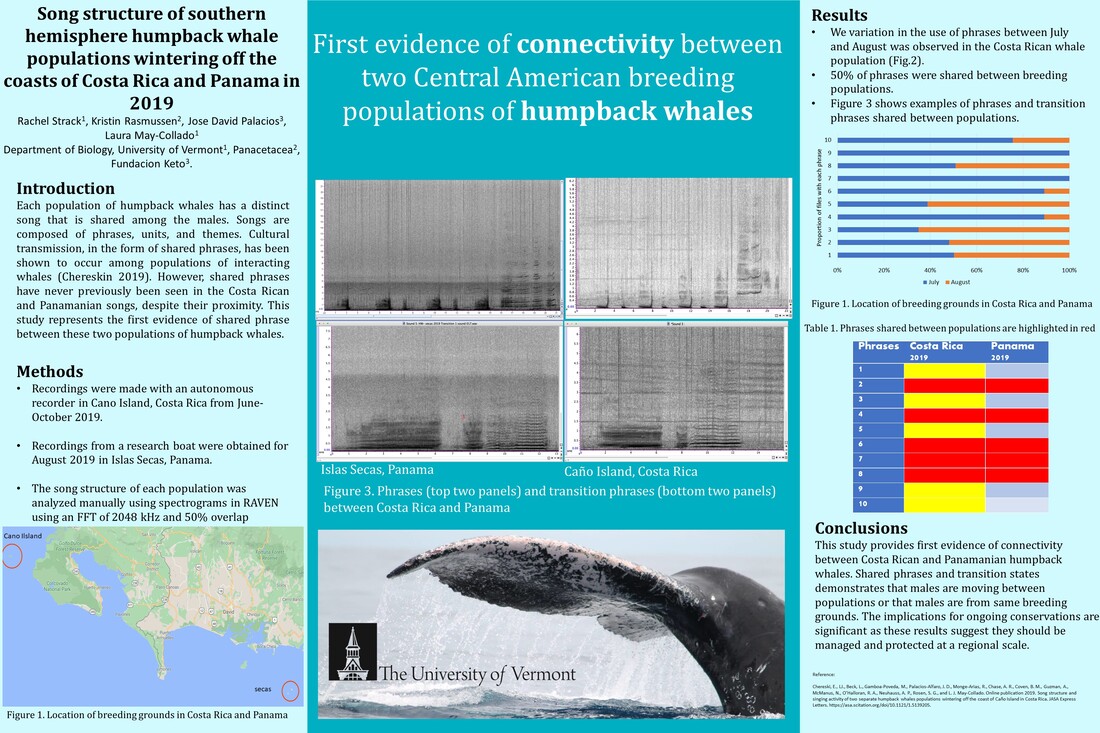 Humpback whale phrase shared by whales wintering of Panama and Costa Rica in 2019
Humpback whale phrase shared by whales wintering of Panama and Costa Rica in 2019 This semester I was lucky enough to have been a part of CURE, an amazing undergraduate opportunity. I had always been interested in the oceans and marine life; however, it wasn’t until this year that I had the chance to learn more about them. It was especially interesting to learn about marine animals in terms of their acoustics, as I had never really known much about that before. My research focused on the song structures of two humpback whale populations, and whether or not they were found to be connected. I had never known the complexity that went into humpback whale songs before beginning CURE, and I am amazed by all of the new information that I have learned about them. I analyzed sound recordings using Raven for my project, and it has really helped me to understand the types of programs that are used for real research. I enjoyed being able to complete my research independently, while also using Dr. May-Collado when I needed her to help me understand something.
I loved being able to be a part of research, and this course really spoke to me, however there were definitely times where it could be very frustrating. Doing real research means you don’t always have the answers, and there were many times where I was confused by what I was looking at or I simply didn’t understand why it was happening. These are the kind of experiences that I cherish, because at the end of the course we were able to determine that the two populations that I was studying are far more connected than previously thought. It is incredibly rewarding to be able to see how the long hours of going through every sound file really payed off. This course has inspired me to pursue marine biology in my future, despite not knowing what I wanted to do other than ‘research’ before I took this course.
I am very appreciative of Dr. May-Collado, because even when I was confused or frustrated, she was able to help me understand that real research takes time, and not everything can be fully explained. Listening to her talk about bioacoustics and the knowledge that she has about them has inspired me so much and I am so grateful for that. If you have the opportunity to be a part of CURE, I would definitely take that chance, because this course is so different than any other course I have taken at UVM, and it really makes you stop and look at the oceans in a different way.
I loved being able to be a part of research, and this course really spoke to me, however there were definitely times where it could be very frustrating. Doing real research means you don’t always have the answers, and there were many times where I was confused by what I was looking at or I simply didn’t understand why it was happening. These are the kind of experiences that I cherish, because at the end of the course we were able to determine that the two populations that I was studying are far more connected than previously thought. It is incredibly rewarding to be able to see how the long hours of going through every sound file really payed off. This course has inspired me to pursue marine biology in my future, despite not knowing what I wanted to do other than ‘research’ before I took this course.
I am very appreciative of Dr. May-Collado, because even when I was confused or frustrated, she was able to help me understand that real research takes time, and not everything can be fully explained. Listening to her talk about bioacoustics and the knowledge that she has about them has inspired me so much and I am so grateful for that. If you have the opportunity to be a part of CURE, I would definitely take that chance, because this course is so different than any other course I have taken at UVM, and it really makes you stop and look at the oceans in a different way.

 RSS Feed
RSS Feed
